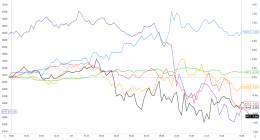The NFL star redefined himself after retirement from the sport, and found a whole new world of opportunity.
December 30, 2019 14 min read
This story appears in the January 2019 issue of Entrepreneur. Subscribe »
Socks. It’s a Tuesday afternoon in October, and Michael Strahan is deep in thought about socks.
“We can do more of these non-solids in a solid,” says Douglas Raicek, president of the trouser division at Peerless Clothing, as Strahan contemplates a pair of gray socks in his hands. The two are at work developing Strahan’s upcoming men’s fashion line for JCPenney, reviewing a rainbow mountain of socks in a glass-walled Manhattan conference room.
“I think that would be more fashion-forward,” Strahan says.
“You can’t be too fashionable, because you still have to appeal to a mainstream customer,” Raicek replies, Strahan nodding.
Michael Strahan: the cheery man with a gap-toothed smile, known to the masses as a Good Morning America cohost, an analyst on Fox NFL Sunday, the $100,000 Pyramid emcee, and now also a fashion designer. Years ago, the whole thing would have been unimaginable. Strahan was a New York Giants football player then, full stop. It’s what he knew, and it’s what he was known for. But for all the money, glitz, and glamour of professional football — the Super Bowl ring, the Hall of Fame status, the healthy salary — Strahan the athlete was painfully aware that he didn’t control his own destiny. When he retired from the game a decade ago, he knew he needed to change that — to learn what it really means to take control and then fully own it. Or to put it in football terms, which Strahan is known to do constantly, he needed to go from defense to offense. “Everything that has come after that hasn’t necessarily been a plan to say, ‘This is step one, and this is step two, and this is step three,’ ” Strahan says, outside the socks meeting. “It’s just been taking advantage of opportunities and creating opportunities to expand and try new things, to try and challenge yourself.”
So that is why Michael Strahan is eager to contemplate socks. It isn’t because of fashion. It’s because, as he’s learned, taking control means digging into details. It means mastering what you don’t know — and in his case, redefining himself as the guy as comfortable among kitchen counters and dresser drawers as he is barreling onto a football field. As the guy who’s the one in charge.
He came from a life in uniform, right down to the assigned socks. Not anymore.

Image Credit: Nigel Parry
Sports is a structured environment, and Strahan’s upbringing prepared him for it. The youngest of six children, he was born into a military family and spent much of his childhood growing up on an Army base in what was then West Germany. He became an NFL Draft prospect in college and was drafted by the New York Giants in 1993.
All told, football was good to Strahan, and Strahan was good to football. He played for a staggering 15 seasons as a defensive end, about four and a half times the average NFL career (which has been estimated to be about three and a third years). This helped him stave off the inevitable question that bedevils even the savviest of pro athletes: What the hell to do once life in the game ends?
RELATED: Maria Sharapova Built a Business Empire Thanks to Her Winning Team
Strahan had seen plenty of fellow players crumble after sports. “The whole identity for most of these guys is sports — what you’ve only done since you were a kid. And now it’s gone,” he says. “And you’re lost.” And yet, Strahan says, he was no better prepared when his time came. He was a 36-year-old man with “no idea” what to do next. “It wasn’t an easy transition at all. There’s a lot of fear because you don’t know what to expect.”
He started with something familiar. Sportscasting is a welcoming pasture for talent off the turf, and he landed a spot on the Fox Sports commentator desk instantly. But leaving football brought up a new specter: the possibility that Strahan may really suck at something. “You don’t want to be the weak link,” he says. “I didn’t want to be that at Fox, and it was a quick, quick learning process.” He kept reminding himself of how carefully he had to speak now that he was even more of a public figure, and sought mental tricks to calm his anxiety. He tried comparing the stress of being on camera with the stress of playing in a Super Bowl, of having a 350-pound warrior trying to smash his head in. “That’s pressure,” he told himself. “Pressure is not shaking a dude’s hand and asking him some questions on camera.”
But he knew this couldn’t be his end goal. Sportscasting was just a base — stable ground on which to build. He began asking colleagues about how the industry operates, learning the levers of power. He wanted to think bigger, inspired by idols in the NBA like Magic Johnson and Michael Jordan, and beyond sports to the Jay-Zs of the world, who took their core talent as a mere jumping off point to creating an empire. “Looking at those guys and their visibility, you always wanted or wished you could have a career after your playing days that is as respectable as theirs,” he says. So once Strahan mastered being on air, he made it known that he was available for other roles. That led to the one sitcom he starred in, 2009’s Brothers, which flopped.
Then a conversation changed everything. Strahan was talking with his manager, Constance Schwartz-Morini, a longtime NFL marketing executive who’d met Strahan during his second year as a pro and had gone on to become a big-time talent manager. (She also counted Snoop Dogg among her roster.) Schwartz-Morini noticed Strahan’s interest in the business side of entertainment and thought he was missing the bigger picture. “You’re not just great on camera; you’re very smart behind the scenes,” she recalls saying to him. So why not partner with her to build an agency?
RELATED: Danica Patrick Spent Years Preparing to Retire — by Laying the Groundwork for a New Career
That got him thinking. Ownership is power, he realized — and even if he landed great TV gigs, that wouldn’t give him ownership. He’d still be beholden to someone else’s whims. So in 2011, he and Schwartz-Morini founded the management company SMAC Entertainment and began building a roster that now includes sportscaster Erin Andrews, rapper Wiz Khalifa, fellow NFL-players-turned-broadcasters Deion Sanders and Tony Gonzalez, and others.
This felt good to Strahan. Ownership was power. “Hopefully,” he says, “it’s power you use in the right way, because it comes with a lot of responsibility.” And Strahan and Schwartz-Morini thought of it that way: In a world where women and people of color are consistently underrepresented, they were now in a position to do something about it.
That, ironically, is also when ABC called.

Image Credit: Nigel Parry
Strahan may have co-owned a talent management firm, but he still wanted to be the talent, too. ABC was offering that. In September 2012, he officially became Kelly Ripa’s cohost on Live!
The exposure gave Strahan a new, wider fan base. He was used to men approaching him and wanting to talk football. “When I started doing Live!, you got the mothers and grandmothers, and pretty soon the same guys who say, ‘I love you with football’ are saying, ‘Hey, I saw that cookie segment!’ And I’m like, What?”
But Strahan was now in an entrepreneurial habit. Rather than seeing change as frightening, he was seeing it as opportunity. His audience had grown exponentially, from sports fans to everyone. So he pounced. He wrote a best-selling book, Wake Up Happy: The Dream Big, Win Big Guide to Transforming Your Life. In 2016, ABC announced that he would be leaving Live! to join Good Morning America. He kept the weekend NFL commentating gig.
Soon he was booking out every moment of his time. With his company SMAC, Strahan began to geek out on content production — launching programs like the Nickelodeon Kids’ Choice Sports awards show, several documentaries, and The Joker’s Wild with Snoop Dogg. When Sony decided to reboot The $100,000 Pyramid, executives quickly thought of Strahan to host it. So he approached the task like a football player: He watched footage of the show with original host Dick Clark, then watched tape of his own rehearsals afterward. “I think it’s an athletic mentality to be really well-prepared and ready to compete,” says Holly Jacobs, Sony’s executive VP of alternative programming and first-run syndication. “When we’re working on the show, he’s involved in a granular way.” For on-air talent, she adds, that can be unusual.
These days, Strahan has more TV exposure by some measures than Ryan Seacrest, his eventual replacement on Live! The game show continues to go strong. (A slot machine game is in the works.) ABC has renewed him for Good Morning America for a fourth year. Between commentating on football games on the weekends and doing cooking segments during the week, Strahan has appeal that crosses gender, racial, and geographic lines, a base marketers salivate over. And he’s mindful of the ways one effort can boost another. He isn’t going to wear just anyone’s clothing for hours on end daily before millions, for example. He’s going to wear his clothing.
Of all this — nearly round-the-clock opportunities where Strahan’s face is beamed to millions of homes — he says something that sounds almost defensively humble: It’s not about me. “If the team is winning, there’s enough credit for everyone,” he says — by which he means that he wants to make a whole project successful, not use it only as a platform to increase his fame. Everything he agrees to, he says, is selected because it’s “something I feel I can make a difference in or add value to.” Strahan is there to add value, not to take it.
RELATED: How Venus Williams Is Serving Up Her Entrepreneurial Dreams
Many celebrities say something similar. Is it true? Strahan is so naturally friendly, so seemingly willing to engage with everyone around him, that it certainly seems like it could be. But here’s another way to look at it: Who doesn’t want to be at the top? Who doesn’t prefer to be part of a team, so long as they’re in some ways the leader of that team? Isn’t this the goal — to reach the place that satisfies you, and then contribute to others’ satisfaction?
“I understand that it’s a bigger team than just you who is on the camera,” Strahan says. “The most important people are the ones behind the camera, the people you should be really nice to. You don’t want to be blurry on TV! You understand how important the support system is in sports, and that has carried over to me in business. Because there’s nothing worse than feeling that you do a job no one values. Each job is important — I don’t care if you’re cleaning out the garbage cans or working the phones or running the company. Everybody has value, and football taught me to make people feel that value to get the best out of them.”

Image Credit: Nigel Parry
Back at the sock meeting in Manhattan, one of Strahan’s colleagues notes that she had preemptively removed “the sock equivalent of an ugly Christmas sweater” from the options in front of Strahan. “They had snowflakes on them,” she explains, “and this is for spring!”
“I want to see them!” Strahan says. “Now I’m interested!”
So the ugly-sweater socks are revealed. Strahan jokes about how they might look good on his goldendoodle, Enzo. Then, once and for all, they’re retired. But Strahan does greenlight a camouflage print and a blue-gray star design — both of which will soon land in JCPenney, along with the rest of his collection.
Strahan’s clothing line is only one data point — one product, one retailer — but it’s become an intriguingly strong one. The Strahan collection first launched in the fall of 2015 in 300 JCPenney stores, and generated a reported $7 million in sales in the first year alone. Within two years, the chain doubled the number of stores stocking Strahan.
“We’ve done a lot of celebrity partnerships,” says James Starke, Penney’s senior vice president, head of merchandising. “None has had the from-the-get-go success that his brand did on our floor.” Starke in part credits Strahan’s cross-gender fandom, estimating that 60 percent of menswear sales at JCPenney are made by women purchasing for a man. “He appeals to everyone, and that’s hard to find,” Starke says. It’s why the line continues to expand — starting with suits, then into athletic apparel, shoes, denim, and jewelry. (And socks, of course.)
In his relationship with JCPenney, Strahan has also learned what any product manufacturer must: The first customer isn’t actually the end consumer — it’s a retailer’s buyers and employees. Win them over, and they’ll sell your brand for you. So Strahan does just that, coming to JCPenney in person to motivate its team. Once, onstage in front of 1,000 employees, he even talked Starke into a little catwalk strut. “He has moves,” Starke says. “I do not.”
“It’s all part of the fun,” Strahan explains. “I love motivating and leading by example.” Again, he draws from football. On a team, he had 50-plus guys from different backgrounds who had to believe in a common goal. “Business is the same way for me — finding that everyone is so different, where they come from, what their interests are, what they do when they leave work. But once they come into your environment, we make sure we all have the same, common goal of being successful and achieving what we want to achieve, and having fun.”
But even now, 12 years into his post-NFL career, Strahan doesn’t feel like he knows exactly what he’s doing. In the scope of his life, he’s been a football player for far longer than he’s been anything else. “In every business we’re in, I have no idea about it,” he says. “I didn’t go to school for being on TV. I didn’t go to school to learn about production or the clothing business.” But he’s learned how unimportant that is — how few of the people around him are prepared in any formal way, and how everyone is, in some respect, learning on the job. The key for him is knowing that he’s now performed the same trick enough times. He’s gone into an unknown situation and succeeded, which means he can do it again. “You have to learn to not doubt yourself, or doubt yourself a little less, so you give yourself at least a chance to compete and to be successful,” he says. “You figure it out, and you have to be open to trying to figure it out. And the risk is really in not being able to try. Because [if you don’t], you never know what you can do, and you’ll sit at home and wonder.”
This article is from Entrepreneur.com








